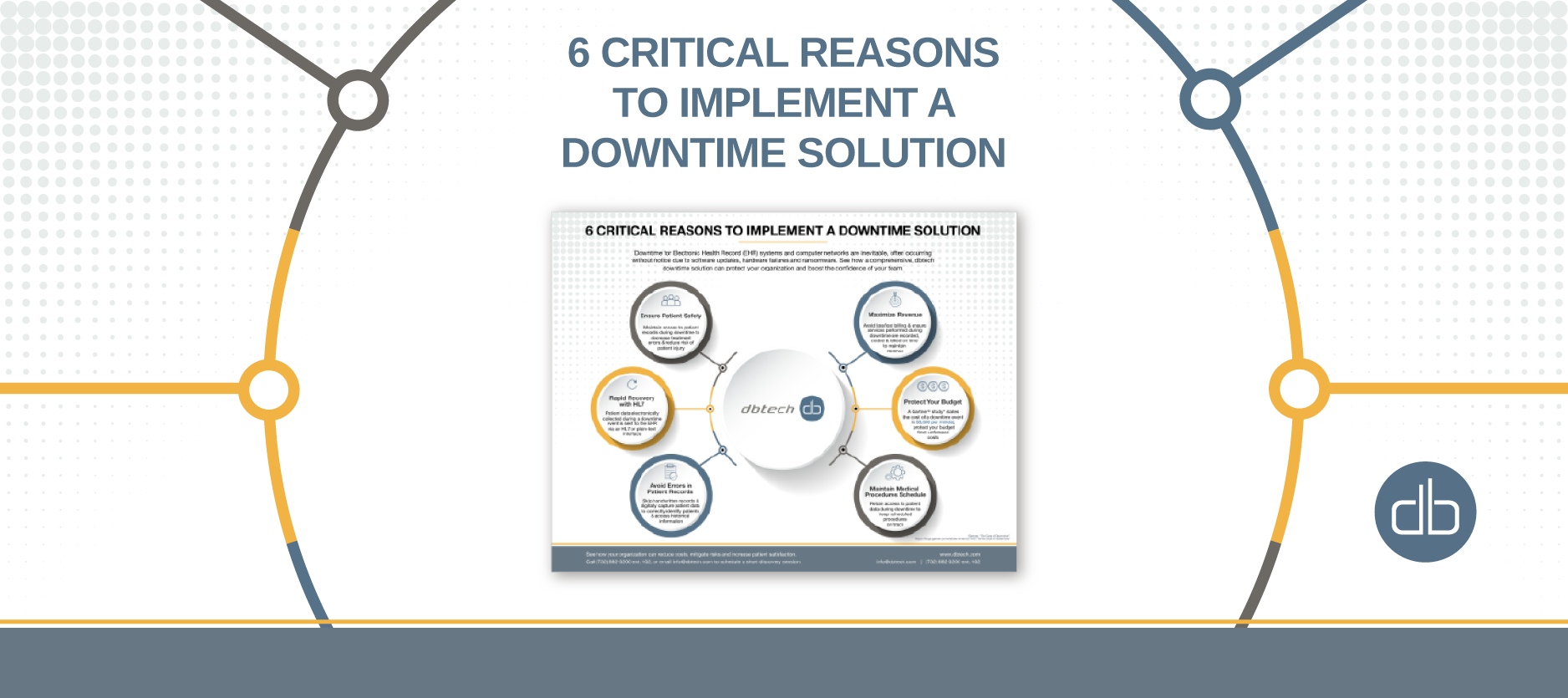
When an Electronic Health Record (EHR) system experiences downtime, it often leaves hospitals scrambling to find viable recovery solutions. Working with paper records while your EHR system is offline can be an inefficient and unworkable solution, making swift recovery essential. Nonetheless, creating and executing a successful EHR disaster recovery plan requires understanding the complexities of these systems—from the risks of downtime to the benefits of a reliable downtime solution. In this blog, we will discuss EHR downtime procedures and examine why hospitals need a robust downtime strategy.
Paper-based EHR Downtime Procedures: Prolonging Recovery & Creating Chaos
During EHR downtime, paper-based procedures often take over. However, such systems can prolong recovery and create chaos in medical facilities. For instance, there may be contention between the Registration and Medical Records departments over who scans the handwritten forms, resulting in lost or misplaced documents. Additionally, entering nursing notes and other information scribbled on paper may be overlooked, leading to incomplete patient records.
Downtime is inevitable, and recovery efforts are necessary regardless of planned or unplanned downtime. The recovery process is influenced by various factors such as downtime duration, time of day, and systems or networks affected. However, relying solely on paper-based EHR downtime procedures can negatively impact recovery time, increase the potential for data breaches, and create confusion and chaos. It is crucial to have an effective backup plan and alternative procedures in place to ensure a smooth and efficient recovery process.
The Drawbacks of a Paper-Based EHR Disaster Recovery Plan
Any healthcare organization that does not have some sort of electronic solution for downtime will have a 100% manual recovery process. Recovery efforts, in this case, are extremely challenging and include the following:
Disorganization of Paper Documentation
Ensuring that every piece of paper on which a patient was “registered,” every photocopied insurance card, every treatment note, and every discharge instruction (the list goes on) is collected and accounted for. That could be information collected from patients at the time of registration or patient treatment that clinicians on paper documented. Missing documentation results in missing patient info, missing treatment info, and even a loss of revenue.
Tedious Manual Data Entry
After attempting to gather all the necessary documentation, staff must now manually transfer the information into the appropriate system. This could include patient registration, charting in the EHR, placing orders and referrals for additional treatment, coding, discharge planning, entering charges and payments, etc. Needless to say, this is time-consuming and often leads to errors.
Difficulties Collecting Patient Data
Determining how to collect information from patients lost or not collected during downtime poses another challenge during recovery. Upon the realization that documentation is missing, hospital staff being sent to patients’ homes days after a downtime event has ended is not unheard of.
Staff Shortages
Manual recovery is extremely time-consuming and often requires extra staff to complete. It is estimated that for each hour of downtime, it takes a day to recover. Hospitals can’t always be prepared to schedule staff based on downtime, so they may still be short-handed during recovery. In addition, the overtime cost gets more expensive the longer the downtime event lasts.
Rescheduling
Recovery efforts include rescheduling patients whose procedures were canceled due to the downtime event. This creates delays in treatment and overbooked schedules and clinicians.
Why Should Hospitals Opt for an Electronic Downtime Solution?
Hospitals face significant challenges during downtime, but electronic downtime solutions can mitigate these. A robust solution enables hospital staff to electronically create, update, and store patient records, reducing the need for manual intervention. Moreover, hospitals can digitize necessary documents like insurance cards, referrals, and treatment notes into these records, minimizing the risks of lost information.
An electronic downtime solution cuts the laborious, costly, and time-consuming recovery efforts by electronically exporting all relevant data to other systems once the downtime event ends. This reduced downtime is crucial to hospitals that prioritize efficiency and patient care. When patient information is collected, documented, and stored electronically, it minimizes the likelihood of missing pieces of data after the recovery process.
How to Reduce Delays & Make a Full EHR System Recovery with dbtech
With dbtech, EHR downtime recovery is streamlined, user-friendly, and efficient. Users merely need to click on a button indicating the end of the downtime event, so dbtech’s Downtime Solution can start listening to the EHR for new registrations again.
All information captured during the Downtime event will be sent back to the EHR through Rapid Recovery. This is an instant transfer of the data from the downtime solution to the EHR using Outbound HL7. Alternatively, the information can be transported via file export if needed.
With a manual system in place, it could be hours, even days, before the information is back into the EHR. Billing delays, anyone?
dbtech: The Backbone of EHR Disaster Recovery
dbtech’s Downtime Solution and Rapid Recovery offer a robust, secure, and reliable solution to downtime events. With our solution, hospitals can quickly recover from an EHR system outage while minimizing the potential for wasted time and other consequences resulting from downtime. Paper-based solutions may seem more straightforward in the short term, but they soon become a liability when recovery time is slowed and data is lost.
dbtech’s solution bridges the gap between manual processes and electronic health records, allowing hospitals to transition from paper-based to electronic ones that are reliable, secure, and efficient. Contact the dbtech team to learn more about how our solution can help your hospital quickly and easily recover from a downtime event.

